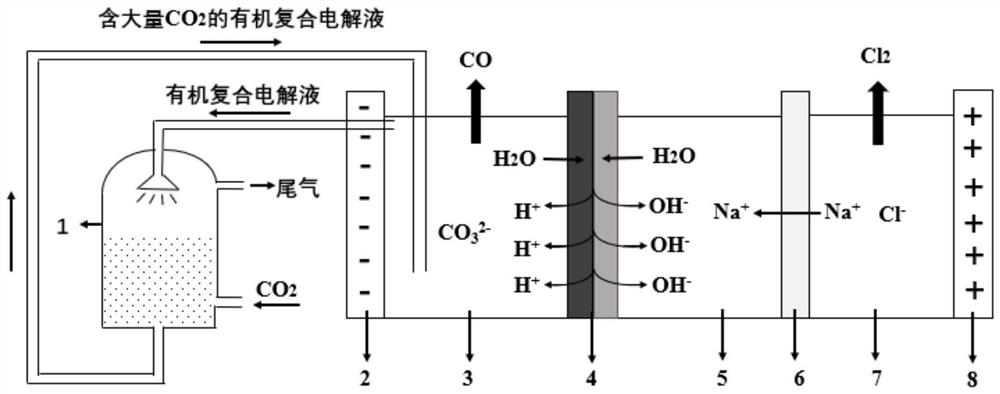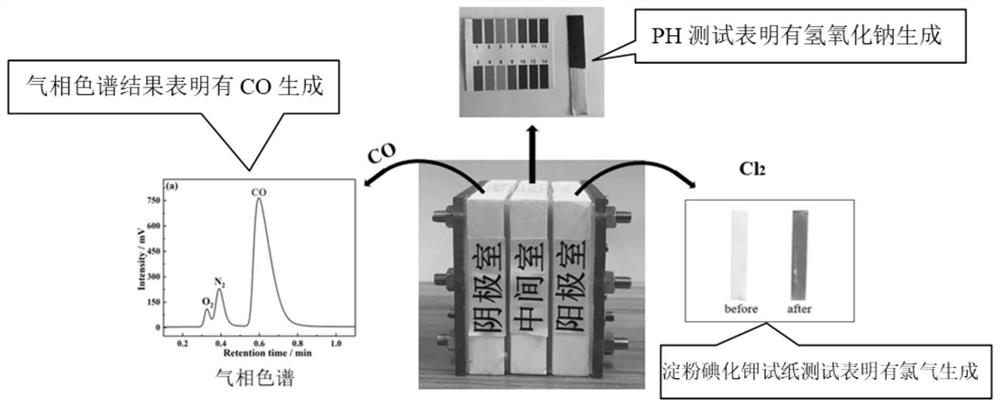Bipolar membrane electrolysis method for preparing carbon monoxide by electrolyzing carbon dioxide in organic electrolyte and simultaneously producing chlorine and metal hydroxide as byproducts
An organic electrolyte and carbon dioxide technology, applied in electrolysis process, electrolysis components, cells, etc., can solve the problems of low cathode reaction current density, accelerated hydrogen evolution reaction speed, and lack of economic feasibility, etc., to achieve good solubility, start and stop Ease of use and the effect of large equipment footprint
- Summary
- Abstract
- Description
- Claims
- Application Information
AI Technical Summary
Problems solved by technology
Method used
Image
Examples
Embodiment 1
[0043] A bipolar membrane electrolysis method in which carbon monoxide is produced by electrolyzing carbon dioxide in an organic electrolyte while by-product chlorine and metal hydroxides, the specific operation steps are as follows:
[0044] Step 1, the electrolytic cell is divided into a cathode chamber, an intermediate chamber and an anode chamber by a bipolar membrane and a perfluorosulfonic acid type cation exchange membrane, an Au electrode is placed in the cathode chamber as a cathode, and an iridium oxide-coated titanium is placed in the anode chamber The electrode acts as the anode, and water is added to the intermediate chamber. The anion permeation layer of the bipolar membrane is an imidazolized polyetheretherketone anion permeation layer with a thickness of 200 microns, and the cation permeation layer is a perfluorosulfonic acid type cation permeation layer with a thickness of 150 microns. The interfacial region of the layer incorporates titania / nickel oxide nanop...
Embodiment 2
[0050] A bipolar membrane electrolysis method in which carbon monoxide is produced by electrolyzing carbon dioxide in an organic electrolyte while by-product chlorine and metal hydroxides, the specific operation steps are as follows:
[0051] Step 1, the electrolytic cell is divided into a cathode chamber, an intermediate chamber and an anode chamber by a bipolar membrane and a sulfonated polyethylene cation exchange membrane, and an Ag electrode is placed as a cathode in the cathode chamber, and IrO is placed in the anode chamber 2 ·Ta 2 o 5 A coated titanium electrode acts as the anode, and water is added to the intermediate chamber. The anion permeable layer of the bipolar membrane is a diamine-containing styrene / ethylene benzyl chloride copolymer anion permeable layer sub-permeable layer with a thickness of 180 microns, and the cationic permeable layer is a sulfonated polyethylene cationic permeable layer with a thickness of 250 microns, introducing polyvinyl acid / polyvi...
Embodiment 3
[0056] A bipolar membrane electrolysis method in which carbon monoxide is produced by electrolyzing carbon dioxide in an organic electrolyte while by-product chlorine and metal hydroxides, the specific operation steps are as follows:
[0057] Step 1: Separate the electrolytic cell into a cathode chamber, an intermediate chamber and an anode chamber with a bipolar membrane and a sulfonated polystyrene cation exchange membrane, place a Zn electrode as a cathode in the cathode chamber, and place a glassy carbon electrode as an anode in the anode chamber , add water to the middle chamber. The anion permeation layer of the bipolar membrane is a quaternized polyvinyl chloride anion permeation layer with a thickness of 210 microns, and the cation permeation layer is a sulfonated polyvinylidene fluoride cation permeation layer with a thickness of 150 microns. The interfacial region of the permeation layer incorporates sulfonated polyether ether ketone as a water dissociation catalyst....
PUM
| Property | Measurement | Unit |
|---|---|---|
| thickness | aaaaa | aaaaa |
| thickness | aaaaa | aaaaa |
| thickness | aaaaa | aaaaa |
Abstract
Description
Claims
Application Information
 Login to View More
Login to View More - R&D
- Intellectual Property
- Life Sciences
- Materials
- Tech Scout
- Unparalleled Data Quality
- Higher Quality Content
- 60% Fewer Hallucinations
Browse by: Latest US Patents, China's latest patents, Technical Efficacy Thesaurus, Application Domain, Technology Topic, Popular Technical Reports.
© 2025 PatSnap. All rights reserved.Legal|Privacy policy|Modern Slavery Act Transparency Statement|Sitemap|About US| Contact US: help@patsnap.com



